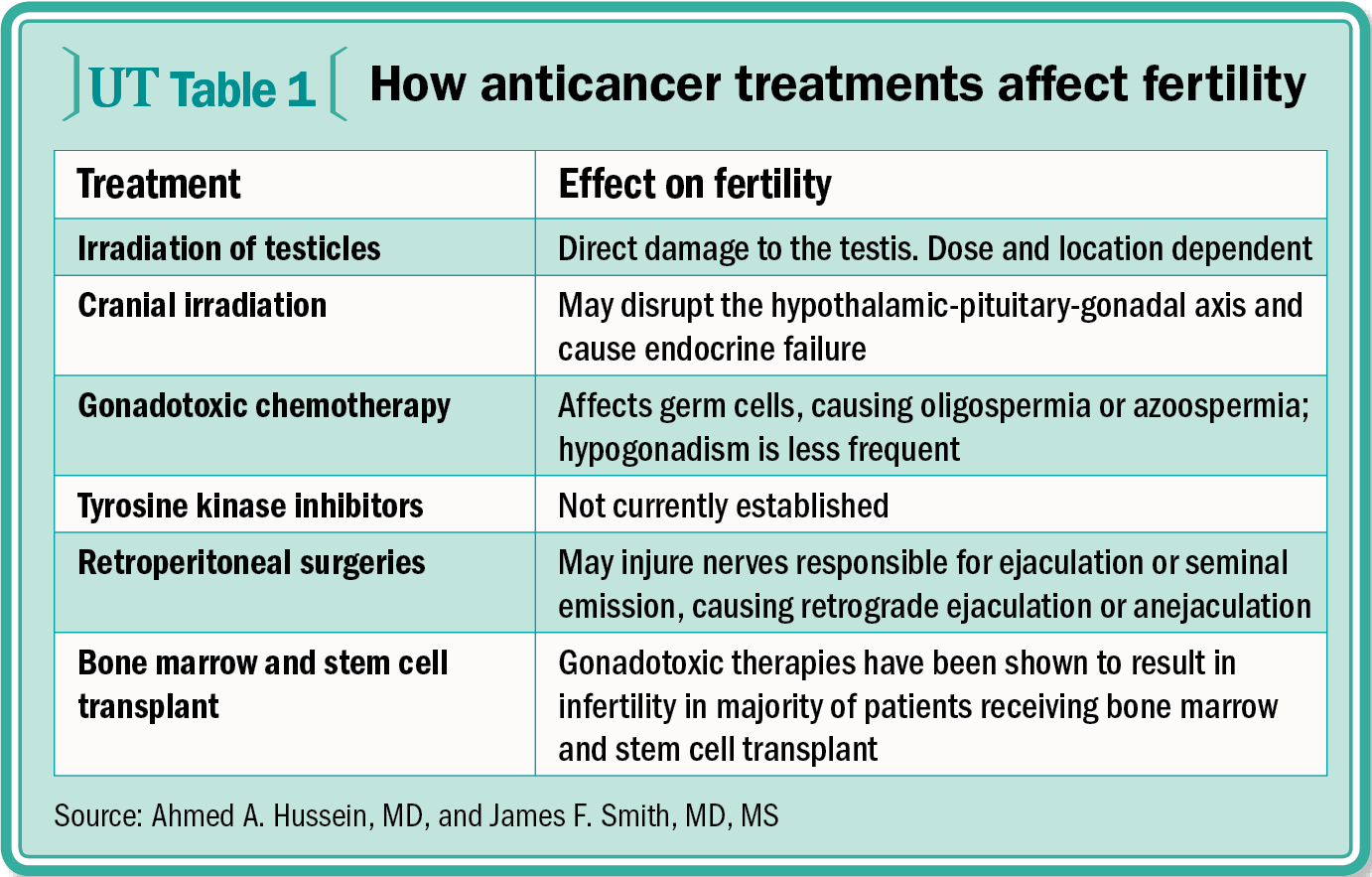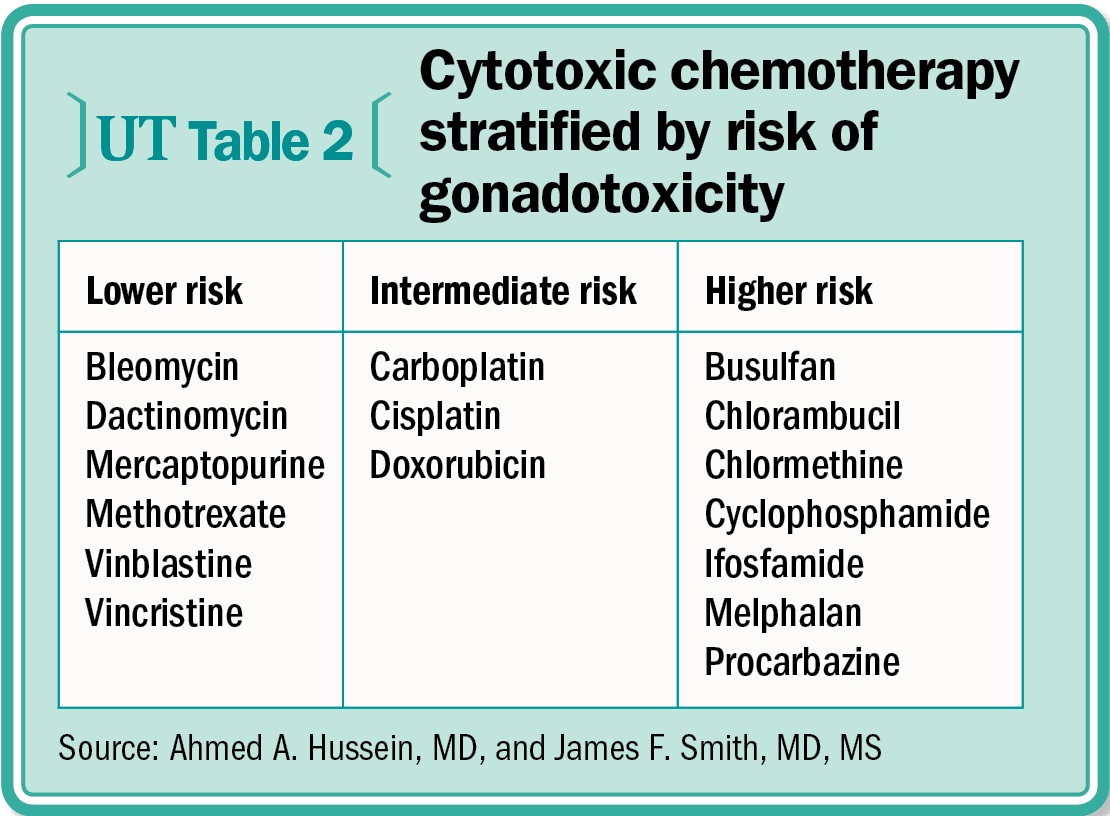Article
Oncofertility: Current practice and vision for the future
In this article, Ahmed A. Hussein, MD, and James F. Smith, MD, MS, examine the effect of malignancy and anti-cancer treatment on fertility, review current fertility preservation methods, and offer a preview of fertility preservation techniques that hold future promise.



The number of cancer survivors has grown over the past several decades as a result of advances in diagnosis and treatment. Cure and survival remain each patient’s top priority, but improved survival has spurred greater interest in quality of life after treatment. Comprehensive cancer care for male patients should aim at “minimizing the cost of cure” and maintaining their overall well-being, including their ability to father children. Unfortunately, many may not be able to have children due to the effects of cancer and its treatment.
Related - How to manage testicular/groin pain: Medical and surgical ladder
In this article, we examine the effect of malignancy and anti-cancer treatment on fertility, review current fertility preservation methods, and offer a preview of fertility preservation techniques that hold future promise.
How can cancer affect fertility?
Many types of cancer are associated with impaired semen parameters and infertility. Pain and constitutional manifestations (eg, fever and anorexia) have been associated with impaired semen parameters. Prior to initiation of any treatment, patients with Hodgkin’s disease, testicular cancer, and extragonadal germ cell tumors have impaired semen quality (Ann Oncol 2001; 12:1307-11).
Anticancer treatment can cause persistent or long-lasting damage to the testis. The extent of damage varies with the cancer type, patient age, and type and dosage of the treatment modality (table 1). Typical cytotoxic therapy disrupts spermatogenesis by targeting rapidly dividing spermatogonial stem cells.
Next: Effects of RT, chemo, surgery, bone marrow and stem cell transplant on fertility

More "Hands On" articles
How to prevent stone formation in patients with metabolic syndrome
The azoospermic male: Contemporary evaluation and treatment
How to talk to patients about prostate cancer screening
Radiotherapy. Direct irradiation of the testicles, as in cases of leukemic infiltration of the testes or as part of whole-body irradiation prior to bone marrow transplantation, causes direct damage of the testis. Cranial irradiation of brain tumors may cause disruption of the hypothalamic-pituitary-gonadal axis and endocrine failure. This side effect can occur with doses as low as 1.2 Gy, and irreversible damage occurs with doses of 4 Gy or more. It is worth mentioning that Leydig cell function (ie, testosterone production) is usually maintained for doses up to 20 Gy (J Endocrinol 1989; 120:161-5). Therefore, infertility secondary to oligospermia or azoospermia can occur despite normal development of secondary sexual characteristics.
Chemotherapy. Similar to radiotherapy, gonadotoxic chemotherapy affects mainly the germ cells, causing oligospermia or azoospermia, with hypogonadism a less frequent consequence. Alkylating agents such as cyclophosphamide and busulfan carry the highest risk of infertility (table 2). In addition, most chemotherapy regimens involve the use of a combination of agents, which may have a synergistic detrimental effect on fertility. The risk posed by targeted therapies, such as tyrosine kinase inhibitors, to male fertility and pregnancy outcome is yet to be established. Patients should be counseled about the risks of infertility and consider pre-treatment sperm cryopreservation.
Surgery. Retroperitoneal surgeries, such as retroperitoneal lymph node dissection or resection of retroperitoneal tumors, may injure nerves responsible for ejaculation or seminal emission, causing retrograde ejaculation or anejaculation.
Bone marrow and stem cell transplant. Bone marrow and stem cell transplantation are necessary therapies for many malignant and benign conditions. Worldwide, more than 50,000 procedures are performed annually, with more than half of the patients in their reproductive age. An integral part of the procedure is to use “induction” chemotherapy and/or radiation therapy and then replace it with highly specialized stem cells that develop into healthy bone marrow. These gonadotoxic therapies (eg, pelvic irradiation or alkylating agents such as cyclophosphamide and busulfan) resulted in infertility in greater than two-thirds of pediatric patients who had received allogeneic stem cell transplant in one study (Bone Marrow Transplant 2012; 47:271-6).
Next: Methods of fertility preservation

Methods of fertility preservation
Semen cryopreservation is a well-established fertility preservation method for sexually and reproductively mature males. Prompt referral to a fertility specialist and banking as many samples as possible prior to treatment is crucial. The quality and number of healthy cryopreserved sperm determines the future reproductive options available to each patient. Advancements in semen cryopreservation in conjunction with in vitro fertilization (IVF)/intracytoplasmic sperm injection (ICSI) have revolutionized fertility options for subfertile patients.
Other options have been proposed to protect against the effects of radiotherapy, including fractionation of the radiation dose, shielding the testicles during radiotherapy, and surgical relocation of the gonads away from the radiated field. Alterations in the chemotherapy protocols have been also proposed. However, the effectiveness of these methods remains questionable (Pediatrics 2008; 121:e1461-9).
The role of oncologists and other providers
The medical oncology team should emphasize the possible fertility consequences of the anticancer treatment. Oncologists appropriately focus on cancer survival and generally select treatment with the highest survival outcome. However, this should be done in the context of comprehensive care of the patients and minimizing the early as well as late adverse effects, including infertility.
Physicians and other health care providers should address infertility as a possible consequence for cancer treatment, counsel them about fertility preservation strategies, and promptly refer them to a fertility specialist if needed. The American Society of Clinical Oncology has recommended that all patients facing sterilizing therapy should be advised of these risks. Patients should be referred as early as possible for sperm cryopreservation during the small window between diagnosis and the initiation of treatment. Men with poor sperm quality on these initial semen samples should be rapidly referred to and seen by a reproductive urologist to discuss pre-treatment fertility preservation strategies. Establishing a network between fertility specialists and practitioners dealing with cancer patients, with prompt referral of patients during the window after diagnosis and prior to receiving the cytotoxic therapy, would maximize the patients’ fertility preservation chances (J Clin Oncol 2013; 31:2500-10).
Obstacles to fertility preservation
Awareness of fertility preservation. Following their cancer diagnosis, patients are usually overwhelmed by the cancer diagnosis and prognosis, and may not be aware of or initially concerned about the possible effects on their fertility. Moreover, many may not be aware of the possibility of fertility preservation, or think it may cause a delay in cancer treatment and therefore worsen prognosis. Health care providers should provide clear information about these risks, the fact that fertility preservation rarely delays cancer treatment, and promptly refer patients for fertility preservation.
Cost. The estimated cost of preserving three semen samples for 3 years has been estimated at approximately $1,500 (U.S.). Further, the utilization of this sperm may require IVF/ICSI, an approach that can cost a patient over $20,000 (J Urol 2014; 191:427-32). For many, failure of insurance to cover fertility preservation makes these services inaccessible. Health care providers should encourage their patients to explore their insurance coverage and advocacy programs such as Livestrong, Fertile Hope, and other charitable organizations to identify financial assistance. Many sperm banks facilitate the process of payment by offering monthly payment plans, which may make it more affordable (J Clin Oncol 2013; 31:2500-10).
On the other hand, under the Affordable Care Act, infertility services are not included among the list of Essential Health Benefits. Moreover, it includes some guidelines that may inhibit couples from seeking fertility treatment. Currently, the Internal Revenue Service tax code considers storage of sperm and IVF as non-reimbursable medical expenses. The new tax code will allow deductions for fertility treatments of more than 10% of patients’ income rather than 7.5%, resulting in a significant reduction of the amount a couple can claim.
Next: Future fertility preservation options
Future fertility preservation options
Many promising investigational methods for fertility preservation are in development, particularly for prepubertal boys facing sterilizing cancer treatment. In the two most promising methods, a testicular biopsy is obtained and cryopreserved prior to cancer therapy. Thawed testicular tissue could be used either for in vitro maturation of sperm cells or cells could be transplanted back to the patient after successful cancer treatment. Mouse models have demonstrated the potential for success of using neonatal testicular tissue differentiated in vitro to mature sperm and used for IVF/ICSI (Nature 2011; 471:504-7). A number of animal models have successfully demonstrated the feasibility of autologous spermatogonial stem cell transplantation, a technique that utilizes thawed testicular tissue reintroduced to the patient’s testicles after cure (Cell Stem Cell 2012; 11:715-26, Biol Reprod 2009; 81:898-905). Together, these exciting techniques provide new horizons for fertility preservation in boys.
Conclusion
Dramatic improvement in survival after cancer therapy has spurred much interest in post-treatment quality of life for male cancer patients, including their ability to father children. Semen cryopreservation is a well-established method of fertility preservation for men treated with potentially sterilizing cancer therapy. Although promising fertility preservation approaches for prepubertal boys are under investigation, many hurdles remain before these approaches can be offered widely.
Educating patients about the risks of infertility after cancer treatment and referring them for fertility preservation should be done early after diagnosis for men at risk for impaired fertility. Establishing a link between fertility specialists and physicians involved in treating cancer patients is crucial to provide these services effectively.UT
Subscribe to Urology Times to get monthly news from the leading news source for urologists.
Newsletter
Stay current with the latest urology news and practice-changing insights — sign up now for the essential updates every urologist needs.













